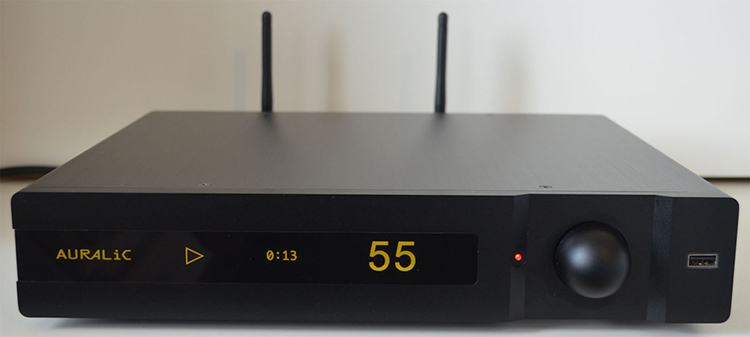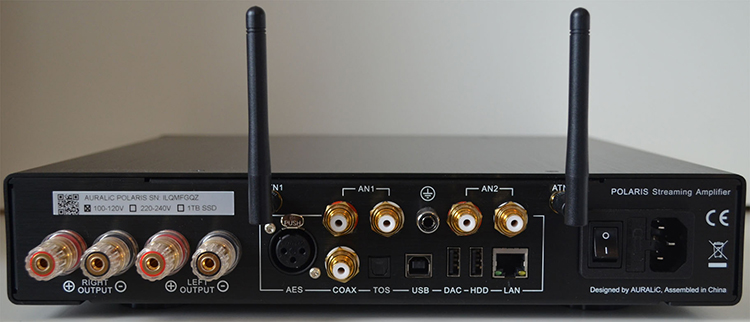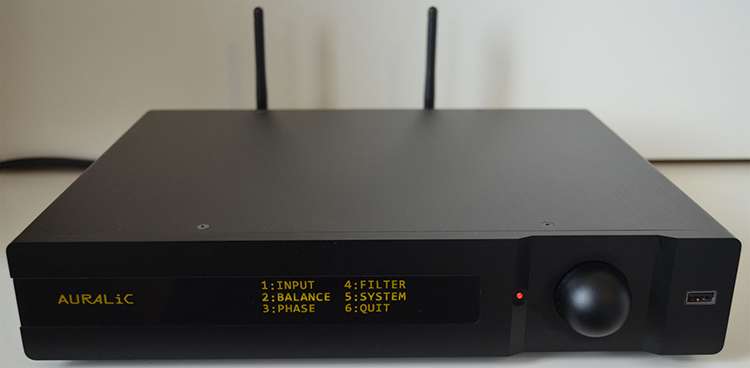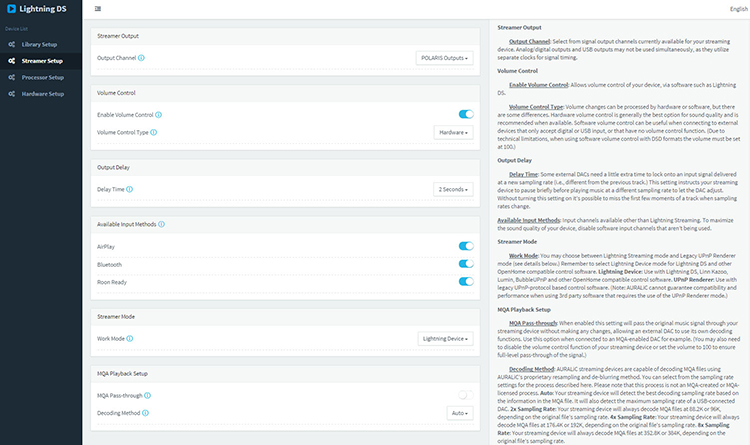Except for the headphone control, the POLARIS can pretty much assume all the other functions of the ALTAIR, which means it can serve as a DAC, a digital preamplifier, a Bluetooth streamer, and a high-resolution network streamer. In addition, AURALiC also manages to pack a powerful stereo class-D power amplifier module in the POLARIS, which can deliver 120 W/channel into 8 ohm or 180 W/channel into 4 ohm loads. Moreover, with two pairs of analog channels that can be configured as line-stage input, phono-stage input, or preamplifier output, the POLARIS can assume the functions of a conventional integrated amplifier. AURALiC also includes a Hybrid Volume Control feature in the POLARIS, which uses a combination of both analog and digital domain controls together for optimum audio performance at all volume levels. All these features are good, but what matters most is still its sonic performance. Only then you will be able to determine whether the POLARIS carries a lot of bang for the buck. Read on to know more details about the POLARIS.

AURALiC POLARIS Wireless Streaming DAC Amplifier
- Integrated stereo amplifier with phono-stage, DAC, Bluetooth, and network-streaming capabilities.
- Support for high-resolution DSD/DXD/MQA audio formats.
- Configurable analog input/output connections.
- Powerful proprietary hardware platform for high-speed digital processing capability.
- Streaming control via app on smartphone or tablet, including Apple AirPlay.
- Compact size with excellent built quality and finish.
- Excellent sonic performance in all modes.
If you are a regular Secrets reader, you are probably aware that not too long ago I reviewed a product from AURALiC, called the ALTAIR, which is a multi-function DAC with wireless and high-resolution network streaming capability. I came away very impressed with the features and performance of the ALTAIR, especially in streaming high-resolution audio signals via a network. Needless to say, I was full of expectations when I was offered to review the POLARIS, a new addition in the AURALiC’s ever-expanding product lineup.
Continuous Output Power:
120W/180W (8 ohm/ 4 ohm)
Frequency Response:
20 – 20KHz, +/- 0.5dB
THD+N:
<0.01%, 20Hz-20KHz at 1W
Dynamic Range:
124dB, 20Hz-20KHz, A-weighted
Streaming Inputs:
Network shared folder, USB Drive, Internal Music Storage (with optional HDD installed), uPnP/DLNA Media Server, TIDAL and Qobuz streaming, Internet Radio, AirPlay, Bluetooth, Songcast, RoonReady
Digital Inputs:
1x AES/EBU, 1x Coaxial, 1x Toslink, 1x USB device to computer, 2x USB host to storage and DAC , 1x RJ45 Gigabit Ethernet, 1x 802.11b/g/n/ac Tri-Band Wi-Fi
Analog Inputs:
Line Stage (input sensitivity 2V rms), MM Phono Stage (Gain: 36dB, 65mV at maximum)
Analog Outputs:
Single Ended RCA (6V rms @ 0dBFS), Loudspeaker Binding Post
Supported File Formats:
AAC, AIFF, ALAC, APE, DIFF, DSF, FLAC, MP3, OGG, WAV, WV, and WMA
Supported Digital Formats:
All PCM from 44.1KS/s to 384KS/s in 32Bit (through USB input and streaming only), DSD64, DSD128, DSD256 (through USB input and streaming only), MQA
Control Software:
AURALiC Lightning DS for iOS, AURALiC RC-1 remote control, OpenHome compatible control software, uPnP compatible control software, Roon
Power Consumption:
Sleep: <10W, Playback: 450W at max
Dimension:
13”W x 10.2”D x 2.6”H (33cm x 26cm x 6.5cm)
Available Finish:
Matte Black / Matte Silver
Weight:
10.0 pounds (4.5kg)
MSRP:
$3799
Company:
SECRETS Tags:
AURALiC, Wireless Streaming, DAC Amplifier Reviews 2017
As a relatively-young Beijing-based audio company (founded in 2009), AURALiC seems to strive in offering unique unconventional audio creations to the high-end audio community. The POLARIS, reviewed here, is called a wireless streaming amplifier, which in my opinion, under-describes what POLARIS actually is. Yes, it has a wireless-streaming capability and it houses a stereo power amplifier in it, but the POLARIS has more functionalities than just a wireless streaming device with amplification. It can serve as a classical integrated amplifier accepting both analog line-level and phono inputs, a stand-alone DAC, and a hybrid analog/digital preamplifier. I guess, it is not easy to come up with a short but descriptive category for an unconventional versatile product like this. The more hats the product wears, the more difficult to categorize. In this case, I believe a new category should be created encompassing the multi-function nature of such product. Perhaps integrated wireless streaming DAC amplifier?
Secrets Sponsor
Mr. Xuanqian Wang, the President and CEO of the AURALiC Ltd., informed me that the POLARIS was designed as a single-box solution to serve as the center of a high-fidelity stereo system, which can replace a combination of a separate analog preamplifier, a phono stage, a stereo amplifier, a digital music server, and a DAC. The POLARIS can be considered as a combination of the ALTAIR and a class-D stereo amplifier plus some extra functionalities. With all these features, it carries an MSRP of $3799, which is twice as much as the ALTAIR. It might seem expensive, but that depends on how you look at it. The cost should be evaluated based on using the POLARIS to replace the main components in your system, not to add it as an additional component. The more crucial question would be whether it is worth its price of admission. This review hopefully sheds some light on this.
Since the ALTAIR and the POLARIS share some common functions and features, some repetitive information with what you read from my review report on the ALTAIR is inevitable. However, to avoid being too repetitive, where appropriate I will just make a reference to my previous review of the ALTAIR. Also, comparison between the two products will be made in various parts of the review as I believe it will provide useful information for the readers who are interested in getting to know these products better.
The POLARIS has the same compact chassis dimensions, finish (available in matte black or matte silver), and appearance as the ALTAIR. Their built and finish quality is excellent. The amplifier in the POLARIS makes it 3 lbs heavier than the ALTAIR. The review unit came in a matte-black finish, which looks unassuming but handsome. The POLARIS also comes with the same remote-control device as the ALTAIR.

The front panel of the POLARIS sports a clean and uncluttered arrangement with a rotary volume knob (which can also be pressed for powering on or putting the unit to sleep) and a relatively large LED display window. The only difference between the front panel of the POLARIS and the ALTAIR is the presence of a USB port on the POLARIS in place of the headphone jack on the ALTAIR. Of course, the back panels of the two units are easily differentiated, highlighted by the presence of the speaker output connectors on the POLARIS. Besides the speaker outputs, the power-plug receptacle and the main on-off switch, the rear panel includes connectors for digital inputs (in the form of AES/EBU, coaxial, and toslink), USB input/output, Ethernet input, two pairs of single-ended RCA connectors (analog channels), and a pair of antenna sockets for attaching the supplied Bluetooth and Wi-Fi antennas.
The two pairs of analog channels are configurable, which adds to the versatility of the POLARIS. The first pair, labeled AN1, can be configured as a line-level input or phono stage, and the second pair, labeled AN2, can be configured as a line-level input or preamp output. With this feature, no additional component is needed to use the POLARIS with a vinyl turntable. Moreover, should you wish, you can use the POLARIS fully as a preamplifier, or use the preamp output to bi-amp your speakers (with an external amplifier) or to connect to powered subwoofer(s).

Just like the ALTAIR, the POLARIS packs high-quality components capable of accommodating the latest technological advances in digital audio processing, including the AURALiC’s proprietary Tesla G1 hardware platform powered by a Quad-Core Coretex A9 processor running at 1 GHz and equipped with a 1 GB DDR3 onboard memory and 4 GB system storage. The platform has a 25,000 MIPS processing capability, which should be more than enough to decode a vast spectrum of audio formats, including AAC, AIFF, ALAC, APE, DIFF, DSF, FLAC, MP3, OGG, WAV, WV and WMA.
The digital to analog conversion is handled by the Sabre 9018K2M chip, which is capable of handling up to 32 bit/384 kHz processing rate. The dual-frequency Femto Master Clock, which is powered by a dedicated extremely low noise power supply, is used to optimize the ESS Sabre DAC chip, enabling the POLARIS to lock on with highest clock precision at a sampling rate multiple of 44.1 kHz or 48 kHz.
As in the ALTAIR, four filter modes are included in the POLARIS: precise (default), dynamic, balance, and smooth. The default precise mode produces the flattest frequency response that is well extended into treble range, the dynamic mode has a gentler high frequency roll-off for great in-band performance, the balance mode reduces the pre-ringing and echo effects to generate very smooth sound, and the smooth filter eliminates these pre-ringing artifacts and further reduce the echo effects for best overall musical presentation. The manual is quite on point in suggesting the filter mode to use for various types of music, although your taste and system will eventually determine which filter to choose.
Another advanced feature unique to the POLARIS is the Hybrid Volume Control, which works in both the analog and digital domain. The analog attenuators reduce the signal level in 12dB steps whilst the DAC’s internal digital volume control handles small amounts of volume change within each step. Such volume control is intended to yield better dynamic range and sound quality at low volume levels.

Right out the box, the POLARIS is ready to use with wired analog or digital connections. Users just need to select the proper input to play. For wireless applications, some initial device setup is needed, which can be done relatively quickly by accessing its menu system using the rotary knob on the front panel or using the remote control. The manual explains the setup steps quite clearly, however for the most part, the POLARIS’ menu system is quite simple and intuitive, and thus I could do it without referring too much to the manual.
The initial network setup of the review unit required the company’s proprietary Lightning DS app, which only ran on iOS platform. However, AURALiC has just recently released the latest firmware update (version 5.0 for POLARIS and ALTAIR, released on June 5, 2017) that comes with web-browser based control software, which is accessible from any platform, and thus, an iOS device is no longer needed for initial network setup or to change the operational setting of the POLARIS. This is a very welcome news for non-iOS users like me. The web-browser based control in the current release has simple interface and is nicely organized. Explanation on what each setting means is also included, as can be seen from the screen snapshot in the figure below. Once the POLARIS has been established as a streaming device in the network and its streaming server has been identified, besides the Lightning DS app, there are third-party OpenHome/UPnP control apps that can be used in other operating systems, such as BubbleUPnP and Roon. Music streaming can also be controlled using Apple AirPlay compatible software, such as iTunes.
For everyday streaming playback control of the POLARIS, I mostly used the free app BubbleUPnP, from my Android smartphone. This app works well with the POLARIS for the most part, giving me control of the network-accessed storage device and cloud music servers such as TIDAL. The app can also handle DSD/DXD music streaming at its full rate and resolution. With the latest firmware, upsampling options (or even downsampling) for PCM and DSD signals are available. This firmware also adds MQA-decoding, which was not there in the previous version. The process uses AURALiC’s proprietary re-sampling and de-blurring method, which is not the same as the MQA-licensed method.
I used the POLARIS in various configurations in this review, trying to get a feel on how good it is handling various tasks. After all, it is a multi-function device by design, and thus its performance in meeting its design objectives will be the focus of this review. In part of my review, I used the POLARIS with my NHT Evolution T6 speakers in my main system, which required me to set one of the analog channels (AN2) to preamp output for bi-amping. This configuration was also used when I tested the POLARIS fully as an analog preamplifier/DAC. But that configuration did not give the full picture of the amplifier’s performance and thus, I also paired the POLARIS with a non-biamp-able floorstanding speakers that I have in my second system, the Onix Rocket RS750.
Music files from various sources were utilized in the evaluation, including CD music files read through the Bel Canto CD3t CD transport, compressed/lossless music files (mp3, AAC, wav, etc.) from a USB hard disk, mp3 files through Bluetooth, and compressed/high-resolution music files through network streaming from local networked storage and from TIDAL.
First of all, I noticed that the POLARIS can become quite warm after being in use for some time, so good air circulation around it is recommended. During the review, I did not experience any major problem with the hardware operation of the POLARIS. A minor quirk that I encountered was the need to re-setup the wireless setting after restarting my router for example due to a brief electricity outage. This quirk, however, was not a consistent one, so it was not too big a deal. Also, it can be easily alleviated by connecting the POLARIS to the network using an Ethernet-cable.
Secrets Sponsor
The POLARIS has a 0−100 volume-level range in a step of 1. The volume control can be configured to affect all inputs the same way (master mode) or to adjust each input individually. But regardless of the volume-control configuration selected, when an input has just been selected, the volume level will start at 20 and then gradually increase to its last set value. This feature is to prevent a loud pop that might occur during input change. There is no unity-gain bypass feature provided, but the ability to set individual-input volume levels can be used to alleviate the integration issue with a home-theater processor. I did this by setting the volume level of one of the analog inputs that was used as a bypass to its maximum (100) and let my home-theater processor take over the volume adjustment. In doing it this way, there is still a chance the volume can be changed by accident. Hence, a fixed/variable volume feature would be a welcome addition to the POLARIS.
Input switching can be accessed through the remote control or by using the front-panel rotary knob. Switching among inputs is relatively quick, except when switching into the network-streaming channel (labeled IPOD on the remote control). It takes about 10-15 seconds for the POLARIS to reconnect to the network. The LCD display of the POLARIS has good-sized amber lettering that is easy to read from across the room. This display has three brightness-level adjustments and can be turned off/on from the remote control.
At the very soul of the POLARIS is a high-quality DAC, which plays an important role in its overall performance characteristics. The POLARIS has the same DAC section as the ALTAIR and I found their implementation produces an equally first-rate DAC performance. In this day and age, people often store and play their music through their computers. AURALiC seems to embrace this trend particularly well. The USB DAC performance of the POLARIS was one of the best that I have ever tried. In fact, this USB input supports PCM signals with sampling rates up to its DAC chip capability (32 bits/384 kHz) and able to stream DSD signals. In that regard, playback of music through the POLARIS from my laptop or conventionally from my CD player led to equivalently satisfying results.
A good break-in period is needed before the POLARIS blooms to its fullest, especially when its amplifier is utilized. This may have something to do with its class-D design, which typically requires longer break-in time than some conventional designs (class A or AB). So, try not to form your conclusion too quickly when you give the POLARIS a listen. It sounded a bit uninvolving and rather dull when it was first fired up. After broken-in though, my impression on its sound totally changed.

I would characterize the sound from the POLARIS amplifier as smooth yet detailed with nice balance across the frequency spectrum. In fact, it drove my Rocket RS750 speakers better than most amplifiers that I have ever paired them with. It truly made the RS750 sing.
The POLARIS amplifier is powerful overall, rated at 120 W/channel into 8 ohm and 180 W/channel into 4 ohm, and did not seem to over-emphasized certain frequency ranges. Dynamically it was excellent and it moved the woofer with poise and control, more so than what its petite-size indicated. The Rocket RS750 is by no means a large floorstanding speaker, and thus, to generate good bass out of the speaker, physics says the speaker’s woofers have to move a lot of air.

The POLARIS had no problem in squeezing out a good level of bass from these speakers. Take for example the track The Road… from the pianist Keiko Matsui’s album with the same name (2011). This track contains a high-dose of low bass, which disappears completely when played through small bookshelf speakers.
This low-bass information was conveyed convincingly and with good authority by the POLARIS through the RS750. Overall, I felt than the POLARIS’ capability to produce the low-end of the frequency spectrum was nothing short of excellent.
Of the four filter modes available on the POLARIS, I found myself gravitating more towards using the precision and smooth modes. At least with the systems it was placed in, these two modes gave me the best results. When paired with the NHT T6 speakers, which is quite neutral and revealing, the smooth filter mode yielded the overall best result. However, with the Rocket RS750 speakers, which tilts more toward laid-back and warm sounding, I preferred using the precision mode.
The POLARIS is also no slouch in conventional integrated amplifier mode, conveying line-level analog input signal to the speakers with a high-degree of neutrality and transparency the way an integrated amplifier should be. All analog signal inputs still need to go through the analog-to-digital conversion (ADC) process, but the digitization is performed in a much higher sampling rate (in DSD256 format) than is typically done in a digital preamplifier. This shows the willingness of AURALiC to go the extra distance to minimize the possible information loss due to digitization. Coupled with the Hybrid Volume Control feature, my listening evaluation suggested that the POLARIS could hold its ground extremely well in dealing with analog signals when compared to other respectable analog products out there.
I did not have an integrated amplifier to compare to during the review, but to give the readers some idea, in my main system, while the POLARIS did not beat the more expensive combination of Krell KAV280p preamplifier and Bel Canto EVO200.2 amplifier in conveying the last bit of transparency and dynamics in the analog music signals, but it sure gave the combo a serious run for the money.
What truly separates the POLARIS with the rest of the pack is its high-resolution network-streaming capability. Without repeating too much what I’ve already mentioned in the review of the ALTAIR, I will just say that streaming of high-resolution DSD/DXD/PCM/MQA music format through the POLARIS fleshes out a higher-degree of transparency and detail that can potentially be more musically captivating. Thus, having a device with such a capability at your fingertips is what I call embracing the future of high-resolution music reproduction. Even if it is being used mostly for just CD-quality streaming, rest assured you will get high-quality results with the POLARIS.
Most of the time during my review, I played CD-resolution music from TIDAL Hi-Fi streamed through the POLARIS with excellent results. As far as I was concerned, doing it this way yielded the same excellent sonic performance as when I played back my music through my CD transport. Moreover, the convenience, as well as the access to the vast music library, was hard to beat.
THE AURALiC has set a high performance-to-cost value standard with the POLARIS, which is a superb-sounding integrated amplifier equipped with phono-stage, DAC, Bluetooth, and high-resolution DSD/DXD/MQA network streamer.
- Elegantly unassuming look with great built quality and finish
- Excellent performer in all modes with tons of features
- Very capable Bluetooth and high-resolution DSD/DXD/MQA streamer
- Web-browser based Lightning DS software environment
- Excellent sonic performance with digital or analog music formats
- Fixed/variable volume setting
This versatile product possesses features and performance that will make it a great centerpiece for a modern high-fidelity stereo system.
The AURALiC POLARIS is a versatile audio product that is more than capable to take centerstage of a high-end stereo system. Basically, you just need to add a pair of speakers to have an operational music system, as the POLARIS has wireless and network-streaming playback capability under its long list of features. This well-built elegantly-unassuming product has the versatility of a swiss-army knife and equally adept in processing both analog and digital music signals. The POLARIS seems to leave its competitions behind with its DSD/DXD high-resolution network-streaming capability. Although it is different than the MQA-standard decoding method, AURALiC also includes its own processing method for MQA-encoded music files in the current firmware. With these tons of features and its excellent sonic performance, the POLARIS represents a value-product at its $3799 price tag. Without a doubt, this is a truly superb product that I can wholeheartedly recommend!




